 for the Tycho-2(1)
cross-scan and in-scan difference are close (81 and 86 mas,
respectively), and the biases are small (-1 and +5 mas, respectively). For
Tycho-2(2)
for the Tycho-2(1)
cross-scan and in-scan difference are close (81 and 86 mas,
respectively), and the biases are small (-1 and +5 mas, respectively). For
Tycho-2(2)  is increased
to 145 and 133 mas, and the biases become +1 and +10 mas.
is increased
to 145 and 133 mas, and the biases become +1 and +10 mas.
i. Comparison of 2MASS Catalog Positions/Uncertainties with Tycho-2
2MASS Point Source Catalog (PSC) positions and uncertainties are evaluated via comparison to the Tycho-2 reference catalog. Tycho-2 stars which were previously included in Tycho-1 are referred to herein as "Tycho-2(1)," and those new to Tycho-2 as "Tycho-2(2)". The positional accuracy of the two Tycho-2 subsets differ considerably, and comparisons are made separately. In addition to global statistics, systematic variations with sky position, scan position and magnitude are presented. Where appropriate, observations made from the northern and southern hemispheres are evaluated separately. In some instances the results are further broken down by read type (Read_1, Read_2-Read_1).
To reduce spurious matches trimming was done at a radial separation of 1000 mas, and only the closest 2MASS match to a given Tycho-2 source was retained.
Figure 1 shows the normalized histograms
of 2MASS vs. Tycho-2 differences, with cross-scan position
in the left panel and with in-scan position in the right panel. Tycho-2(1)
data are shown using heavy black lines and Tycho-2(2) using
light red lines. The "dx" cross-scan difference parameter is
roughly equivalent (except near the celestial poles) to a true-angle RA
difference, but opposite in sign. Thus, when "dx" is positive,
the 2MASS position is west of the Tycho-2 position. When "dy" is
positive, 2MASS position is north of the
Tycho-2 position. Note that  for the Tycho-2(1)
cross-scan and in-scan difference are close (81 and 86 mas,
respectively), and the biases are small (-1 and +5 mas, respectively). For
Tycho-2(2)
for the Tycho-2(1)
cross-scan and in-scan difference are close (81 and 86 mas,
respectively), and the biases are small (-1 and +5 mas, respectively). For
Tycho-2(2)  is increased
to 145 and 133 mas, and the biases become +1 and +10 mas.
is increased
to 145 and 133 mas, and the biases become +1 and +10 mas.
Figure 2 shows normalized histograms of 2MASS vs. Tycho-2 radial differences. As before, the Tycho-2(1) data are plotted using heavy black lines and Tycho-2(2) using light red lines. The mean radial difference for Tycho-2(1) is 99 mas, and for Tycho-2(2) is 161 mas.
In Figure 3 normalized histograms
comparing the quoted uncertainties for 2MASS and Tycho-2
are presented. Comparison plots are divided into four panels, with the
Tycho-2(1) data presented in the left panels and Tycho-2(2) data in the right
panels. Cross-scan  are presented in the upper
panels and in-scan in the lower. In each case only the 2MASS
are presented in the upper
panels and in-scan in the lower. In each case only the 2MASS
 for sources matched to the specified Tycho-2
subset are presented. 2MASS histograms are in solid black and Tycho-2
in light red. Note that the quoted 2MASS
for sources matched to the specified Tycho-2
subset are presented. 2MASS histograms are in solid black and Tycho-2
in light red. Note that the quoted 2MASS  overlap the high end of the Tycho-2(1)
overlap the high end of the Tycho-2(1)  and the
low end of the Tycho-2(2)
and the
low end of the Tycho-2(2)  .
.
Combining the measured differences (dx, dy) with quoted
 for 2MASS
(sigx2m, sigy2m) and for Tycho-2 (sigxt2, sigyt2)
one can obtain a measure of how well those
for 2MASS
(sigx2m, sigy2m) and for Tycho-2 (sigxt2, sigyt2)
one can obtain a measure of how well those  reflect the actual errors.
The
reflect the actual errors.
The  2 parameters (chi2x,
chi2y) are computed as follows:
2 parameters (chi2x,
chi2y) are computed as follows:
chi2x = (dx*dx)/(sigx2m*sigx2m + sigxt2*sigxt2)
chi2y = (dy*dy)/(sigy2m*sigy2m + sigyt2*sigyt2)
The mean of  2 (given a large number of
measurements) has an expected value of 1.0, if the quoted
2 (given a large number of
measurements) has an expected value of 1.0, if the quoted
 are exactly right.
A value larger than 1.0 indicates that the quoted
are exactly right.
A value larger than 1.0 indicates that the quoted  are too low, and less than 1.0 indicates that they are too high. Of course,
there is no way to tell
for sure which of the
are too low, and less than 1.0 indicates that they are too high. Of course,
there is no way to tell
for sure which of the  (2MASS or Tycho-2) is off.
Figure 4 shows histograms of
(2MASS or Tycho-2) is off.
Figure 4 shows histograms of
 2 values for both Tycho-2(1) and
Tycho-2(2) matches. Cross-scan position is in the left panel and in-scan in
the right. The mean
2 values for both Tycho-2(1) and
Tycho-2(2) matches. Cross-scan position is in the left panel and in-scan in
the right. The mean  2 values
from the Tycho-2(1) differences are 1.05 and 1.11, for cross-scan and in-scan,
respectively. The corresponding
values for Tycho-2(2) differences are 1.35 and 1.07. Assuming the Tycho-2
2 values
from the Tycho-2(1) differences are 1.05 and 1.11, for cross-scan and in-scan,
respectively. The corresponding
values for Tycho-2(2) differences are 1.35 and 1.07. Assuming the Tycho-2
 are properly stated, this
indicates the quoted 2MASS
are properly stated, this
indicates the quoted 2MASS  tend to be a little
too low. The cross-scan
tend to be a little
too low. The cross-scan  2 values for
Tycho-2(2) differences stand out.
2 values for
Tycho-2(2) differences stand out.
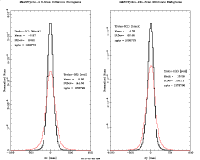 |
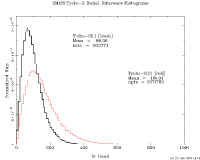 |
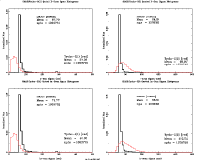 |
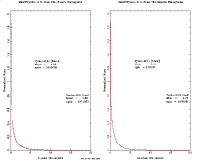 |
| Figure 1 | Figure 2 | Figure 3 | Figure 4 |
Figure 5 shows mean cross-scan (upper panels) and in-scan (lower panels) position differences with respect to both Tycho-2(1) and Tycho-2(2) as a function of RA (left panels) and Dec (right panels). Although small deviations are present, there do not appear to be any large systematic errors as a function of sky position.
Mean radial differences for both Tycho-2(1) and Tycho-2(2) matches are plotted as a function of RA (left panel) and Dec (right panel) in Figure 6. Note that from the Tycho-2(1) values there is a gradual increase approaching the south pole from values less than 100 mas to almost 120 mas. The increase can also be seen approaching the north pole, but it is only about half as large. Interestingly, these effects are not obvious in the Tycho-2(2) data.
The RMS of the 2MASS vs. Tycho-2 differences are shown in Figure 7 as a function of RA (left panels) and Dec (right panels), with cross-scan in the upper panels and in-scan in the lower panels. In addition to being much larger the 2MASS vs. Tycho-2(2) RMS values show systematic changes with sky position not seen with 2MASS vs. Tycho-2(1).
Figure 8 shows mean
 2 values as a function of RA
(left panels) and Dec (right panels).
Cross-scan
2 values as a function of RA
(left panels) and Dec (right panels).
Cross-scan  2 is shown in the upper
panels, and in-scan in the lower panels. In each case Tycho-2(1) and Tycho-2(2)
values are shown separately. Note that the mean cross-scan
2 is shown in the upper
panels, and in-scan in the lower panels. In each case Tycho-2(1) and Tycho-2(2)
values are shown separately. Note that the mean cross-scan
 2 values associated with Tycho-2(2)
differences are not only
larger, but also show greater systematic changes with both RA and Dec. There
are peaks near RA values of 95° and 175°. As for Dec,
values are highest near the equator, dropping almost to one near the poles.
The mean cross-scan
2 values associated with Tycho-2(2)
differences are not only
larger, but also show greater systematic changes with both RA and Dec. There
are peaks near RA values of 95° and 175°. As for Dec,
values are highest near the equator, dropping almost to one near the poles.
The mean cross-scan  2 values associated
with Tycho-2(1), on the other hand, remain near one over most of the Dec range,
rising to higher values only near the south pole.
These differences are difficult to explain in terms of 2MASS uncertainty errors.
2 values associated
with Tycho-2(1), on the other hand, remain near one over most of the Dec range,
rising to higher values only near the south pole.
These differences are difficult to explain in terms of 2MASS uncertainty errors.
Figure 9 shows 2MASS RMS values
derived by substracting in quadrature the quoted Tycho-2
 from the 2MASSvs. Tycho-2 difference RMS
values displayed earlier. If the quoted Tycho-2
from the 2MASSvs. Tycho-2 difference RMS
values displayed earlier. If the quoted Tycho-2  were perfectly characterized, these would be the true 2MASS RMS values, but if
the quoted Tycho-2 sigmas are too low, the derived 2MASS RMS values will be
too high, and vice versa. The derived 2MASS RMS values
are shown as a function of RA in the left panels, and of Dec in the right
panels. Cross-scan is shown in the upper panels,
and in-scan in the lower panels. Values derived from Tycho-2(1) matches are
shown in solid black lines and Tycho-2(2) in light red lines.
For comparison quoted 2MASS
were perfectly characterized, these would be the true 2MASS RMS values, but if
the quoted Tycho-2 sigmas are too low, the derived 2MASS RMS values will be
too high, and vice versa. The derived 2MASS RMS values
are shown as a function of RA in the left panels, and of Dec in the right
panels. Cross-scan is shown in the upper panels,
and in-scan in the lower panels. Values derived from Tycho-2(1) matches are
shown in solid black lines and Tycho-2(2) in light red lines.
For comparison quoted 2MASS  are plotted with
dotted lines, using the same color code. They are slightly different,
because 2MASS sources matched to Tycho-2(2) tend to be fainter than those
matched to Tycho-2(1).
A marked increase in 2MASS RMS near the poles stands out from the Tycho-2(1)
data, as well as a lesser increase near the equator.
The quoted 2MASS
are plotted with
dotted lines, using the same color code. They are slightly different,
because 2MASS sources matched to Tycho-2(2) tend to be fainter than those
matched to Tycho-2(1).
A marked increase in 2MASS RMS near the poles stands out from the Tycho-2(1)
data, as well as a lesser increase near the equator.
The quoted 2MASS  track the Tycho-2(1) derived
2MASS RMS values rather well. The 2MASS RMS values derived from Tycho-2(2)
data show much different characteristics, and the quoted 2MASS
track the Tycho-2(1) derived
2MASS RMS values rather well. The 2MASS RMS values derived from Tycho-2(2)
data show much different characteristics, and the quoted 2MASS
 do not track them.
do not track them.
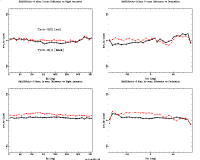 |
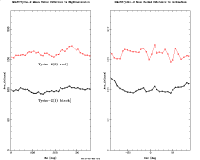 |
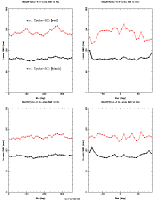 |
| Figure 5 | Figure 6 | Figure 7 |
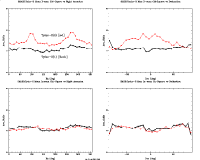 |
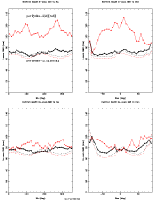 |
| Figure 8 | Figure 9 |
To help evaluate changes with in-scan position each of the 6°-long survey scans is divided into 12 segments, numbered from south to north. Figure 10 shows mean cross-scan (upper panel) and in-scan (lower panel) differences as function of segment number. Note that there is virtually no change in Tycho-2(1) or Tycho-2(2) differences with segment number. Mean radial differences are shown as a function of segment number in Figure 11. The large differences between the Tycho-2(1) and Tycho-2(2) lines are due to the fact that random errors in Tycho-2(2) are much larger. The very slight upturn in the end segments indicate a small increase in 2MASS reconstruction errors near scan ends.
Figure 12, showing mean
 2 values as a function of segment number,
indicates that the quality of the
quoted 2MASS uncertainties is unaffected by in-scan position.
This is borne out by the derived 2MASS RMS shown in
Figure 13.
Note that the Tycho-2(1)-derived 2MASS RMS curves are simply displaced a bit
upward from the quoted 2MASS
2 values as a function of segment number,
indicates that the quality of the
quoted 2MASS uncertainties is unaffected by in-scan position.
This is borne out by the derived 2MASS RMS shown in
Figure 13.
Note that the Tycho-2(1)-derived 2MASS RMS curves are simply displaced a bit
upward from the quoted 2MASS  curves, with little
change in shape.
The Tycho-2(2)-derived 2MASS RMS curves also have this shape, but with a much
larger upward displacement, especially in cross-scan.
curves, with little
change in shape.
The Tycho-2(2)-derived 2MASS RMS curves also have this shape, but with a much
larger upward displacement, especially in cross-scan.
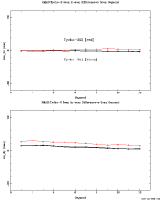 |
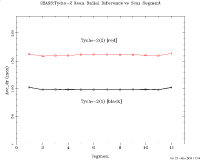 |
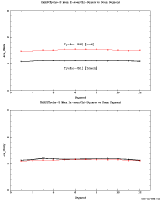 |
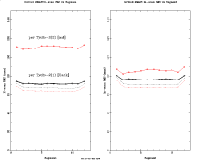 |
| Figure 10 | Figure 11 | Figure 12 | Figure 13 |
Since differences with cross-scan position include telescope/camera
specific effects (such as residual distortion),
data taken from the northern and southern facilities need to be considered
separately. Read_1 and Read_2-Read_1 sources are also considered
separately, given their dual paths through a portion of the pipeline, with
separate distortion removal.
Figure 14 shows mean cross-scan (upper
panels) and in-scan (lower panels) position differences as a function of
cross-scan position (X_us).
The "X_us" parameter increases to the west. Northern facility results
are found in the left panels and southern in the right. Tycho-2(1)
differences are plotted in black, and Tycho-2(2) differences in
red. Read_1 differences are plotted with light lines, and
Read_2-Read_1 differences with heavy lines.
Since the read flags (rd_flg) were not available in the files from
which these plots
were generated and adding them would have taken a great deal of
time, the read type was estimated from the Ks magnitude. All
sources with Ks < 8 mag were tagged "Read_1," and all sources with
Ks > 9 mag were tagged "Read_2-Read_1."
Sources with 8 Ks
Ks 9
mag are typically a mix and were not used.
9
mag are typically a mix and were not used.
Note that there is little difference between Tycho-2(1) and Tycho-2(2) results. In each case the distortion is well corrected for Read_2-Read_1 sources, but not for Read_1 sources. It was only recently discovered that, due to a coding error, the Read_1 positions were pulled out of PFPrep before the distortion correction was applied. This error remained undiscovered during the QA monitoring, because Read_1 and Read_2-Read_1 sources were lumped together, and Read_1 sources make up a small percentage of the total. As it turns out, Read_1 sources have larger errors anyway, so the distortion is a relatively small contributor.
Figure 15 shows mean radial difference as a function of cross-scan position, for the northern hemisphere observations in the left panel and southern hemisphere in the right panel. The Tycho-2(1) differences are relatively constant across most of the scan width, but rise steeply very near the east edge for northern hemisphere data.
Figure 16 shows mean
 2 values as a function of cross-scan
position. Northern hemisphere data are presented in the left panels, and
southern data in the right panels, with cross-scan
2 values as a function of cross-scan
position. Northern hemisphere data are presented in the left panels, and
southern data in the right panels, with cross-scan
 2 on top and in-scan on the
bottom. Northern mean cross-scan
2 on top and in-scan on the
bottom. Northern mean cross-scan  2
values derived from Tycho-2(1) matches become significantly greater that 1.0
only near the east edge. Lessor edge effects can be seen in the northern
in-scan data and the southern hemisphere data. Cross-scan
2
values derived from Tycho-2(1) matches become significantly greater that 1.0
only near the east edge. Lessor edge effects can be seen in the northern
in-scan data and the southern hemisphere data. Cross-scan
 2 values Tycho-2(2) matches are elevated
over the entire scan width for both hemispheres and show little edge effect.
2 values Tycho-2(2) matches are elevated
over the entire scan width for both hemispheres and show little edge effect.
Figure 17 shows derived 2MASS RMS
values as a function of cross-scan position.
As before, the dotted lines represent mean quoted 2MASS
 .
This simply drives home the point from the previous figure. Cross-scan 2MASS
RMS values derived from Tycho-2(1) differences shoot up significantly
only near the
east edge for northern data, and by a much reduced amount for in-scan.
The southern data shows the reduced effect both in-scan and cross-scan.
Cross-scan values
derived from Tycho-2(2) differences are elevated over the entire scan
width.
.
This simply drives home the point from the previous figure. Cross-scan 2MASS
RMS values derived from Tycho-2(1) differences shoot up significantly
only near the
east edge for northern data, and by a much reduced amount for in-scan.
The southern data shows the reduced effect both in-scan and cross-scan.
Cross-scan values
derived from Tycho-2(2) differences are elevated over the entire scan
width.
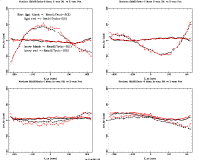 |
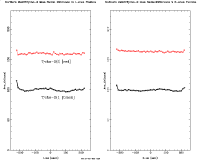 |
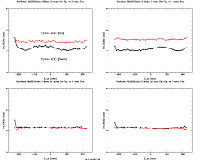 |
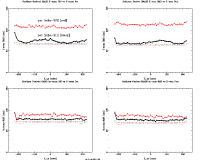 |
| Figure 14 | Figure 15 | Figure 16 | Figure 17 |
Before proceeding into a discussion of variations with magnitude, it is important to note that the magnitude range of Tycho-2(2) matches is shifted fainter than that of the Tycho-2(1) matches, as can be seen in Figure 18. This shift is reflected in the figures to follow. Figure 19 shows mean cross-scan (upper panels) and in-scan (lower panels) position differences as a function of Ks magnitude. As before, northern data are presented in the left panels and southern in the right. Tycho-2(1) differences are plotted in solid black and cover the range Ks = 2.0 - 11.5 mag. Tycho-2(2) differences are plotted in light red and cover the range Ks = 4.5 - 12.5 mag. The primary result from these figures is that there are systematic errors for sources brighter than Ks=4 mag, growing in amplitude to as large as 50 mas by Ks=2.0 mag. This is true in both hemispheres and scan directions, although in-scan error growth is somewhat less.
Figure 20 shows mean radial differences as a function of Ks magnitude, with northern data in the upper panel and southern in the lower. The two hemispheres show very similar results. Although the boundaries are fuzzy, one can interpret these curves in terms of the read type and saturation state. Note that there is a plateau between Ks=5 and Ks=8 mag, which roughly corresponds to the unsaturated Read_1 regime. Mean radial differences rise as one moves from the unsaturated Read_1 plateau toward brighter sources. It peaks just to the bright side of Ks=4 mag, which roughly corresponds to Read_1 saturation. Moving from the unsaturated Read_1 plateau toward fainter sources, the mean radial difference values drop to a minimum around Ks=9 mag, where we are fully into the Read_2 regime. From this point there is a more gradual increase in mean radial difference with increasing magnitude. Tycho-2(2) differences show a faster rise than Tycho-2(1). The RMS of the 2MASS vs. Tycho-2 differences for Tycho-2(1) (black) and Tycho-2(2) (red) are shown in Figure 21 as a function of Ks magnitude, with northern data in the left panels and southern in the right. Cross-scan results are in the upper panels and in-scan results the lower.
Figure 22 shows mean
 2 values as a function of Ks
magnitude. The panels are laid out as before, with
northern data in left panels and southern in the right, cross-scan in the
upper panels and in-scan in the lower. Both Tycho-2(1) and Tycho-2(2)
2 values as a function of Ks
magnitude. The panels are laid out as before, with
northern data in left panels and southern in the right, cross-scan in the
upper panels and in-scan in the lower. Both Tycho-2(1) and Tycho-2(2)
 2 are significantly greater than one
(approaching 2) in the unsaturated Read_1 magnitude range. In the saturated
Read_1 regime the mean
2 are significantly greater than one
(approaching 2) in the unsaturated Read_1 magnitude range. In the saturated
Read_1 regime the mean  2 values drop to
approximately 0.2. In the Read_2 range mean Tycho-2(1)
2 values drop to
approximately 0.2. In the Read_2 range mean Tycho-2(1)
 2 values are a little less than 1.0,
but for Tycho-2(2) mean
2 values are a little less than 1.0,
but for Tycho-2(2) mean  2 values start
above one and increase with magnitude.
2 values start
above one and increase with magnitude.
Figure 23 presents these results in
terms of derived 2MASS RMS values.
The Tycho-2(1) data tell us the quoted 2MASS  are too low by approximately 20 mas in the unsaturated Read_1 region, slightly
too high in the Read_2 region, and considerably too high for sources with
Ks > 4 mag. Tycho-2(2) data indicates that they are too low
throughout the Read_2 region and get progressively worse with
increasing magnitude.
are too low by approximately 20 mas in the unsaturated Read_1 region, slightly
too high in the Read_2 region, and considerably too high for sources with
Ks > 4 mag. Tycho-2(2) data indicates that they are too low
throughout the Read_2 region and get progressively worse with
increasing magnitude.
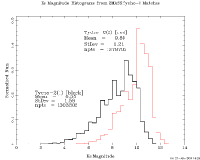 |
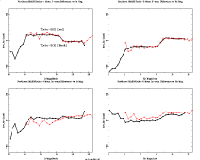 |
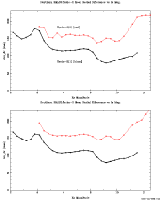 |
| Figure 18 | Figure 19 | Figure 20 |
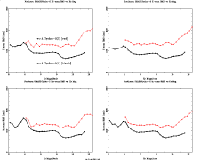 |
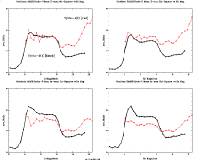 |
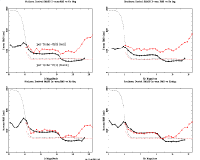 |
| Figure 21 | Figure 22 | Figure 23 |
Based on Tycho-2(1) comparisons, the overall 2MASS reconstruction accuracy appears to be in the range of 70-80 mas, both in cross-scan and in-scan. One should bear in mind, however, that 2MASS sources matched to Tycho-2 are relatively bright. Positional accuracy for fainter sources may be reduced. Also, the fact that Tycho-2 was used as the reference catalog means one must be very careful using it as a measure of success. In theory, one could "nail" the Tycho-2 stars and still leave everything in between much worse off. Analysis of 2MASS:UCACr10 differences, as well as 2MASS overlap differences, however, show that this is not occurring.
Comparisons with Tycho-2(1) cross-scan and in-scan, as well as Tycho-2(2)
in-scan, show the quoted 2MASS  to be overall
about 7% too low.
This appears to be a result of the following three problem areas:
to be overall
about 7% too low.
This appears to be a result of the following three problem areas:
Comparison with Tycho-2(2) indicates the the quoted 2MASS
 in cross-scan is about 23% too low, as opposed
to the 7% from Tycho-2(1).
There is reason to believe this may be be primarily due to an underestimate of
Tycho-2(2) uncertainties, rather than 2MASS uncertainties.
Global comparisons with UCACr10, as well as 2MASS overlap analysis,
are consistent with the Tycho-2(1), not the Tycho-2(2), results.
A detailed 2MASS vs. UCACr10 comparison is presented in
VI.6a2. Combined
2MASS vs. Tycho-2, 2MASS vs. UCACr10, and 2MASS overlap results
as a function of magnitude are presented in
VI.6.
in cross-scan is about 23% too low, as opposed
to the 7% from Tycho-2(1).
There is reason to believe this may be be primarily due to an underestimate of
Tycho-2(2) uncertainties, rather than 2MASS uncertainties.
Global comparisons with UCACr10, as well as 2MASS overlap analysis,
are consistent with the Tycho-2(1), not the Tycho-2(2), results.
A detailed 2MASS vs. UCACr10 comparison is presented in
VI.6a2. Combined
2MASS vs. Tycho-2, 2MASS vs. UCACr10, and 2MASS overlap results
as a function of magnitude are presented in
VI.6.
[Last updated: 2003 Feb 10; by H. McCallon]